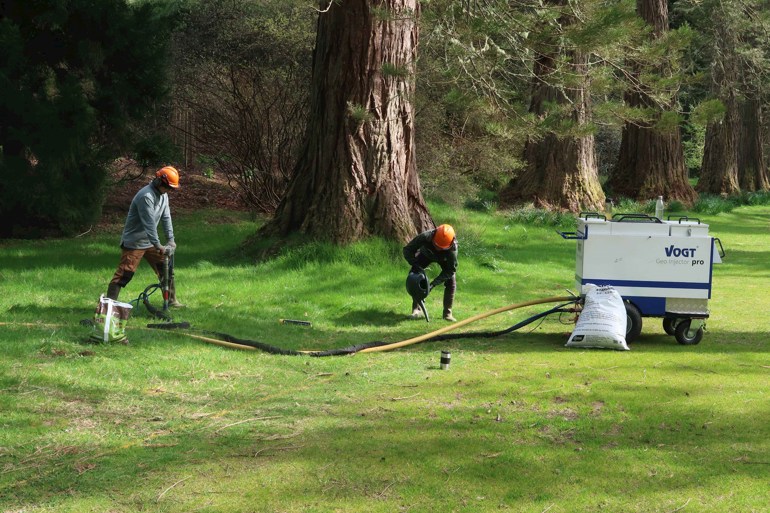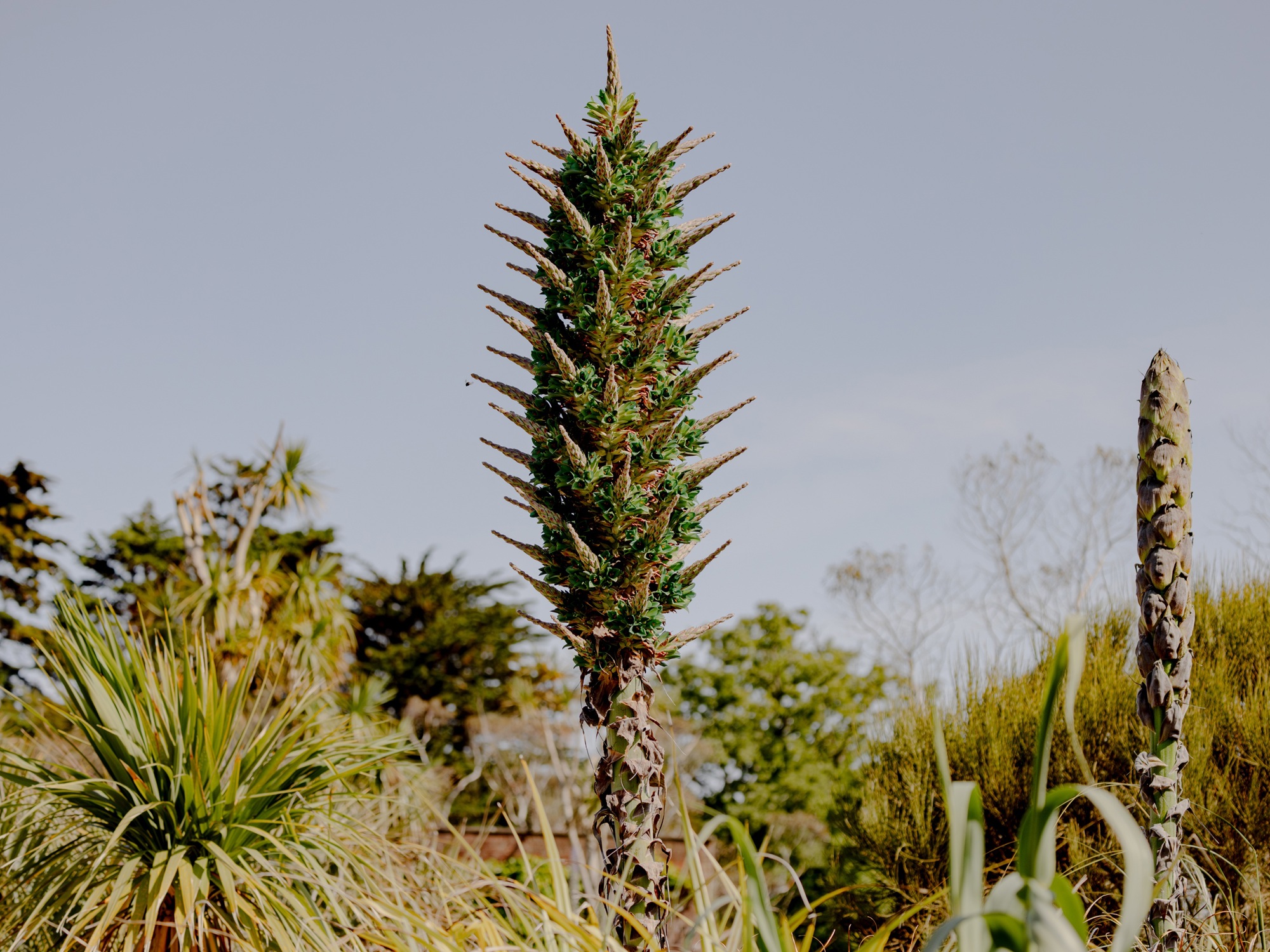Described as one of the finest entrances to a botanical garden anywhere in the world, the magnificent 159-year-old Redwood Avenue at Benmore Botanic Garden, on Scotland’s west coast, has been saved from an early demise through a daring conservation exercise to ward off its susceptibility to plant pathogens.
When the 49 giant redwoods (Sequioadendron giganteum) started showing signs of distress, Curator Peter Baxter and colleagues at the Royal Botanic Garden Edinburgh (RBGE) agreed radical action was required. As branches defoliated and the crowns of the trees started to thin, there was a real risk the trees of the 350m avenue, near Dunoon in Argyll, would succumb to diseases such as phytophthora, the group of plant pathogens capable of inflicting rapid devastation to trees. The race was on to save the stunning specimens and the experts believed the answer was to tackle the situation from the roots up.
Peter Baxter explained: “We were observing the trees going into decline from about 2016. However, the process accelerated worryingly and by 2020 they were existing, rather than growing. My concern was that we were reaching a point of no return.”
The reasons for the decline were complex and multifaceted but soil compaction was thought to be central to the problem. Planted in 1863 by the wealthy US landowner James Piers Patrick, the trees were among the first redwoods introduced to Europe from California and the Avenue was planted along the main driveway to Benmore house. Only a very thin layer of topsoil was supporting the turf over the original hard-core road and this, combined with a typically wet west coast climate and limited drainage, caused serious waterlogging and puddling around the roots, creating a favourable habitat for pathogens, and increasing trees’ disease-susceptibility through stress.
“We believed the best approach would be to employ a combination of breaking-up compacted soil and applying a drainage layer of specialist growing medium to prevent future puddling and waterlogging around the trees to significantly reduce the pathogen pressure they faced. But, that would be an expensive exercise and we didn’t know whether available equipment could work in our climatic conditions.”
Briefly halted by the covid lockdown, the £110,000 project finally took off at the start of the decade. The process involved killing off the grass around the redwoods, then utilising a geo injector to puncture the ground and blow air beneath the surface, breaking-up the compacted soil and making room for the addition of granular materials to largely reduce the likelihood of re-compaction. Breaking the soil improved its structure and aeration, allowing the roots to have the stimulation they need to strengthen and thrive.
RBGE’s Director of Horticulture Raoul Curtis-Machin said the need to save the iconic feature was beyond debate. Noting the virulence of plant pathogens, he also urged those responsible for gardens and estates to work together: “The Avenue is a great responsibility for us, and one we don’t bear lightly. These are landmark trees in the UK landscape, their statuesque dark green heads rising above most others. It has been a joy to see the fresh green growth re-appearing on the branches.
“We are very open to sharing our learnings and experience with other gardens and landowners because we are all in this together now. Climate change and pest and disease threats are coming thick and fast and they don’t respect national borders, county lines or property fences.”
While this battle looks to have been won, RBGE plant health and biosecurity scientist Matt Elliott, concluded on a salutary note on the challenges ahead: “Plant pests and pathogens have become a significant issue in the last 30 years. Gardens contain a wide range of hosts and, therefore, can be particularly susceptible to pest and disease outbreaks. The condition of the host is also crucial, if plants are stressed for some reason, such as climate, pollution and/or soil compaction, they will be more likely to become infected and the resulting disease more likely to be fatal. It is for this reason that we provide plants with the best growing conditions we can, to enable them to fight off diseases.”

ENDS
For further information, interviews, images or to attend the planting ceremony please respond to this email or contact Shauna Hay on 07824 529 028 or Suzie Huggins on 07385 491 460
Avenue work – further detail
At the outset, soil samples collected along the length of the avenue went for analysis, while bark, twigs and foliage samples were also taken and analysed for the presence of pathogens. Comparisons were made in connection with the growing conditions at Benmore and the native habitats of Sequoiadendron giganteum in California.
Bulk density results showed the soils to be compacted, leading to limited oxygen and nutrient availability and increasing the resistance to root growth. A likely contributing factor in the visually apparent physiological stress of the trees.
Soil moisture content was found to be at field capacity, which was creating anaerobic conditions for the tree roots
Deciding the most cost-effective way forward was to purchase the necessary equipment and train the Benmore team in its use, the Garden drew-up a shopping list including a compressor, a geo injector, an injector air and product mixing unit and an air lance.
Phase two brought in the necessary materials for the injection, air lancing and mulching programme. These included: 10 large articulated truck loads (650 cubic metres) of composted fine bark, 54,000 litres of perlite, an initial 800 kilograms of bio stimulant 6,000 kilograms of dried sand topdressing.
The system chosen was to geo inject at one-metre centres to a depth of 500mm, injecting two blasts of compressed air at 100psi followed by two injections of perlite. The perlite keeps the void open allowing free drainage and does not absorb water, improving the free drainage situation. After the injection probe is removed, the hole is backfilled with dry sand.
More than 7,250 square metres of injection took place, equating to the entire area of the length of the avenue, plus outside each side of the avenue to approximately two meters beyond the drip line.
This programme was followed by air lancing all the areas to be mulched. The air lance fires a continuous blast of compressed air at 100psi to the top 200mm of soil or turf. The air lancing de compacts the surface layers and helps create an open tilth.
Mulching to a depth of 100mm followed, the mulched areas were then given a light air lance to help mix a small portion of the mulch into the upper soil layer. Over 6,300 square meters were air lanced and then mulched.
Next, was to add an organic bio stimulant to the mulched areas and then lightly rake in. The bio stimulant helps the microbial activity in the soil, which in turn helps release existing nutrients for uptake by the tree roots.
In the coming weeks the whole project will be rounded off with a new grass strip being planted up the centre of the avenue and final touches quantities of the earlier mixes to complete the invasive work.
At the end of the project, the grass level will be raised by 10 inches.
History
The Redwood Avenue is the iconic feature and place setter for Benmore. Planted in 1863 by the wealthy American landowner James Piers Patrick, it lined the original driveway to Benmore House. Native to California, these redwoods were among the earliest to reach British shores when the species had only just been introduced to the outside world, making the Garden’s redwoods some of Europe’s oldest and tallest, reaching up more than 50m high.
In the wild, individuals are believed to live for three thousand years, attaining heights of over 90m at around 1,000 years old. ‘General Sherman’, widely considered the biggest tree in the world by far, measures over 24m in girth. So, as the Benmore beauties are mere teenagers, at this age they should be reaching vigorously skyward.
Gifted to the nation in 1925 by the Younger brewing family, Benmore Botanic Garden is the oldest Regional Garden of the Royal Botanic Garden Edinburgh (RBGE). It sits on the A815, seven miles north of Dunoon on the Cowal Peninsula and is open daily to the public from March 1 to October 31.
In its magnificent mountainside setting, Benmore is also the largest of RBGE’s four sites. The Garden’s 120 acres are home to a world-famous collection of plants from regions ranging from Japan and Bhutan to Chile and Tasmania. It is also key to research and conservation projects focusing on Scottish plants and fungi.
The Royal Botanic Garden Edinburgh (RBGE) is a leading international research organisation delivering knowledge, education and plant conservation action around the world. In Scotland its four Gardens at Edinburgh, Benmore, Dawyck and Logan attract nearly a million visitors each year. It operates as a Non Departmental Public Body established under the National Heritage (Scotland) Act 1985, principally funded by the Scottish Government. It is also a registered charity, managed by a Board of Trustees appointed by Ministers. Its mission is “To explore, conserve and explain the world of plants for a better future.”

